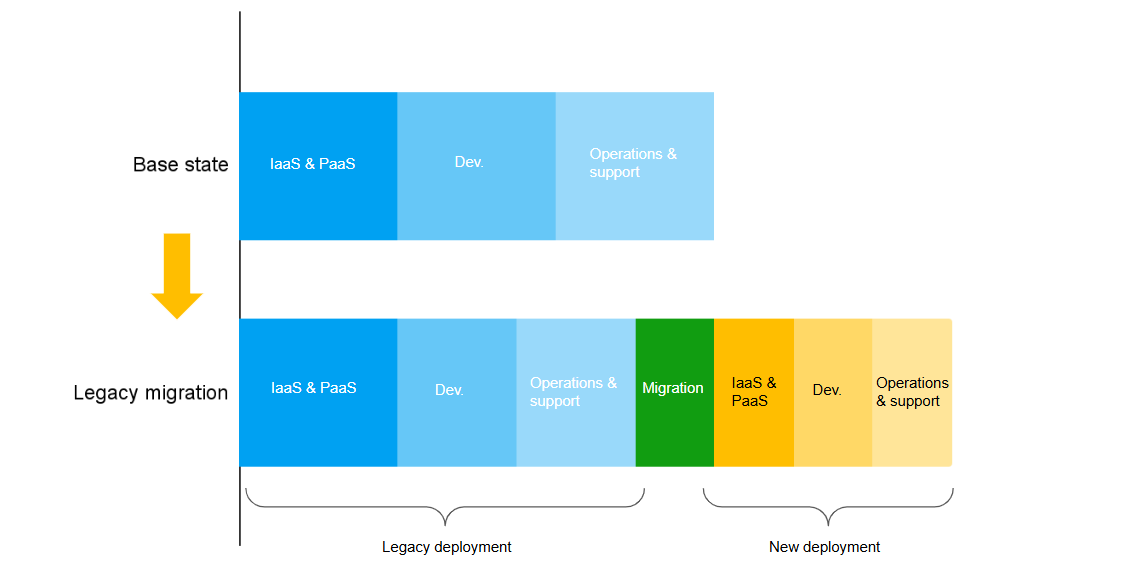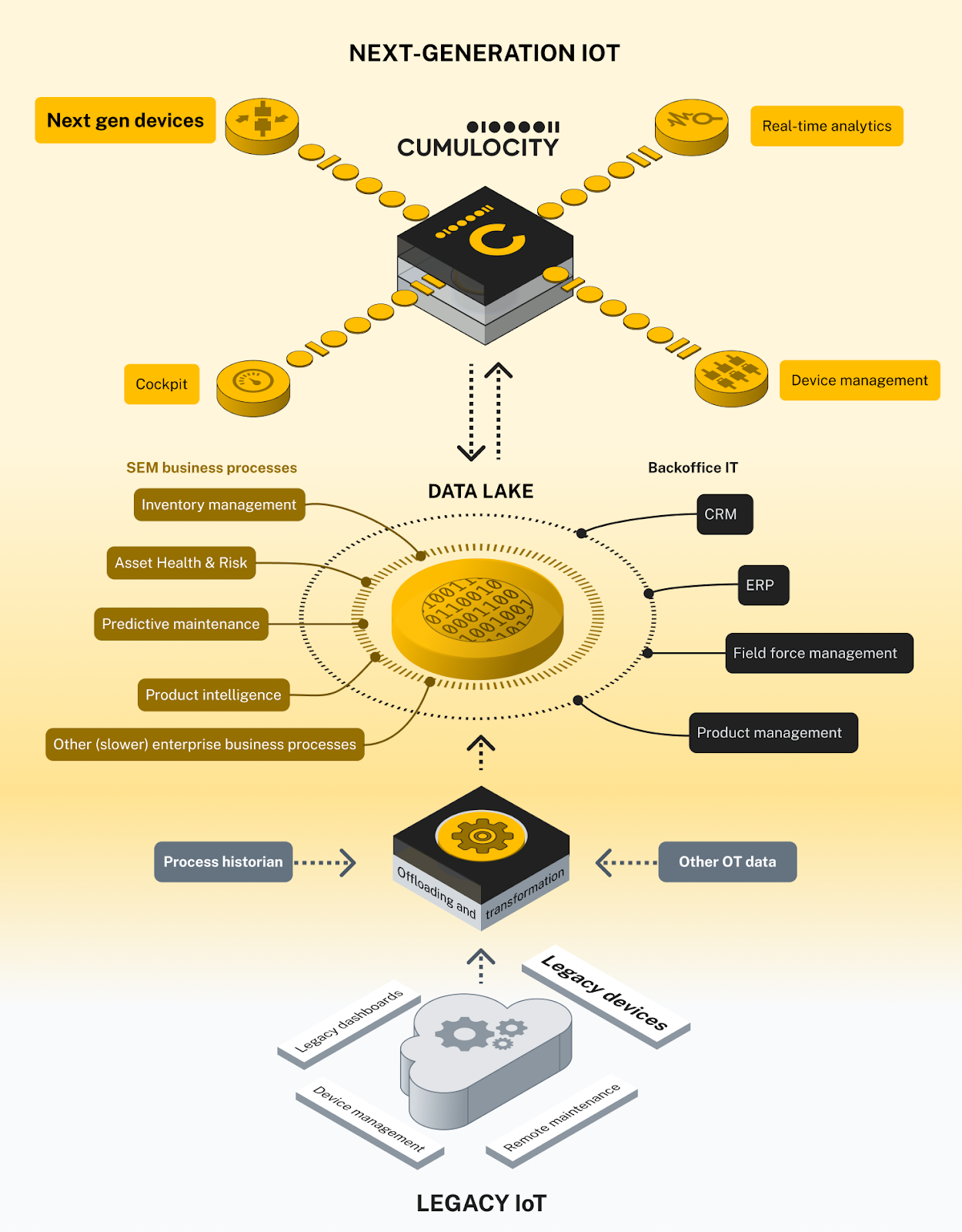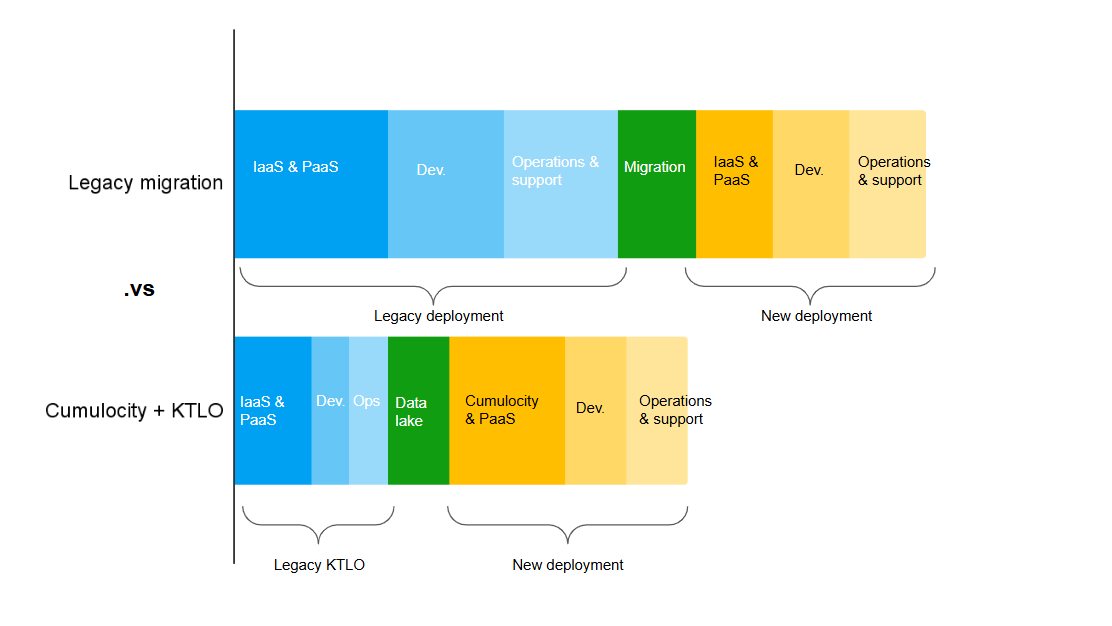whitepaper
Migration without the migraine: An innovative approach to legacy IoT
As IoT implementations mature and become standard for many industries, equipment makers (EMs) are beginning to feel the need to overhaul their first generation IoT solutions. Early IoT systems were groundbreaking by connecting equipment makers to assets in the field. But today, those same solutions often struggle with performance, scalability, and cost-effectiveness. When it comes to rolling out next-generation IoT, customers want advanced analytics, AI-driven insights, and seamless integration into business processes—and this should not result in excessive costs or risk to the EM.
But let’s be real: Nobody’s jumping for joy at the thought of a migration project. Moving from System A to System B can be expensive, time-consuming, and fraught with complexity. As the recent change of leadership at Sonos shows, a botched migration can cause performance issues, lost revenue, and layoffs across the organization. You’d rather spend your resources on innovations that actually add value to your business.
This whitepaper looks at the reasons EMs feel compelled to migrate and the common roadblocks they encounter. It introduces alternative paths that can lower costs, minimize risks, and create a more scalable, future-ready IoT ecosystem.
Why move on? Common challenges with first-gen IoT
Over time, first-generation IoT systems tend to reveal limitations that emerge as solutions scale up or evolve with new demands. Here are some of the main challenges that smart equipment manufacturers face with legacy IoT implementations:
Struggles to keep up with demand: The success of initial IoT services often comes with a new burden: Scaling. EMs are machine experts, not necessarily software companies, and maintaining a production-ready IoT service that can manage thousands or millions of connected devices takes more IT expertise than is feasible.
Cost overload: As production grows, so do the expenses. Many early IoT solutions were full-stack implementations, built from the ground up, often driving up costs on functionalities that don’t directly add value to the EM’s core business. Additionally, running enterprise grade cloud systems at scale can require 24/7 operational shifts, further increasing expenses and straining resources.
A tangle of isolated initiatives: When several product teams or new business acquisitions introduce their own IoT systems, you end up with a “zoo” of platforms and data silos. Analyzing this scattered data across diverse device product lines, and integrating it into EM business processes can become overwhelming.
Lack of a secure enterprise grade design: With security, compliance, and global multi-tenancy demands rising, many first-gen IoT systems show their age. These platforms may not be designed for the variety of modern deployment options, increasing cybersecurity risk and adding unnecessary limits on flexibility.
Unable to meet growing demand for integration and intelligence: Beyond connecting devices, EMs today need IoT solutions that offer deep integration into business processes like asset lifecycle management, fleet management, or field services. Analytics and AI are no longer “nice-to-haves”—they’re vital for smarter, data-driven decision-making. The IoT platform needs to integrate with these tools to develop new digital services, but leveraging these capabilities often requires rethinking both software and hardware.
Does any of this sound familiar?
The reality check: What makes IoT migration so tough?
So, you’ve decided it’s time for change. But before taking the leap, let’s talk about what could stand in your way. Here are some common obstacles that make large-scale IoT migration a challenging endeavor.
High risk to disrupt existing operations
Migrating vast numbers of production devices, especially those with sensitive embedded systems, is risky business. It’s not as simple as pushing new firmware out to a million devices and assuming everything will go smoothly. One small hiccup, and entire fleets of equipment could be disconnected or rendered unresponsive, causing a massive disruption for both you and your customers.
High expectations for future capabilities
The second-system effect often leads teams to believe the new platform will address all the problems with the first system. But these high expectations come with high demands: The new system is expected to deliver all current features while adding new ones. This pressure to achieve feature parity can cause the project to carry over every legacy complexity, delaying release timelines and complicating development even in the long run.
High costs during the transition
A new platform doesn’t mean the old one vanishes overnight. During the transition, you’ll be supporting both systems—each with its own costs, resources, and ongoing customer demands for new features. This dual-system phase leads to duplicated development efforts, as each system may require parallel updates, which stretches budgets and resources thin.
High workload for the development team
Ultimately, the vision for your new IoT platform is to drive differentiation, open up possibilities in AIoT, and bring powerful analytics into play. However, early on, much of the team’s time goes into less exciting, non-differentiating work: Configuring and integrating the cloud provider’s PaaS stack to meet your specific needs. If your strategy involves multiple cloud providers, this setup phase can become even more demanding, slowing progress toward your real goals.
Ultimately, your cost structure will resemble the sketch below. While you might reduce some development costs by scaling back roadmap features for the legacy platform and cutting legacy ops and support costs through fewer updates, the reality is stark: Either your total costs nearly double, or your new platform faces a slow start due to resource constraints.

Figure 1. The cost structure of a classic legacy migration.
A smarter path forward: Don't migrate, innovate!
There is an alternative to the costly, risky overhaul of a rip and replace migration: An adaptive, risk-conscious and business-driven approach that minimizes many of the downsides. The “secret sauce” of this approach consists of the following ingredients:
- Focus on data and business processes: Integrate data and processes between IoT implementations with a focus on innovation, differentiation, and business needs instead of redoing the same functionality as-is in a new system.
- Reduce risk and cost: Keep the legacy systems fully operational, but functionally frozen (“keeping the lights on” or “KTLO”). In particular, do not migrate legacy devices unless there is a case-by-case business decision, hereby opportunistically optimizing the legacy system for cost.
- Make the most of Software-as-a-Service (SaaS): Build on out-of-the-box SaaS for non-differentiating functionality in the new system.
Focus on data and business processes
The main idea of the approach, as illustrated in the diagram below, is to establish a unified data foundation by bringing together data from both legacy systems (at the bottom of the diagram) and next-generation IoT (at the top) through a central hub, which is a data lake. This central data lake can then enable higher-level business processes such as asset health management and integration into back office IT systems such as field force management across the entire fleet of devices, legacy and new.

Figure 2. Business-driven legacy IoT integration.
So what is a data lake?
A data lake leverages open-source technologies such as Parquet and Iceberg, which have become industry standards for data integration. These technologies use cost-effective, high-performance mass object storage, such as AWS S3 and Azure Data Lake Storage, to store and query data, delivering substantial savings and performance gains over traditional operational stores – even at scale.
For example, one of Cumulocity’s customers stores approximately 280 GB of device data daily in their operational store. In the optimized data lake, this same data amounts to just 12 GB per day—a reduction of more than 23 times. Additionally, data lake storage costs are about five times lower per GB compared to operational storage in this case. Together, these efficiencies result in savings of up to two orders of magnitude.
The biggest advantage? The foundation is simply files written in a standard format — think of it as an “XLS on steroids.” This simplicity has fostered a whole ecosystem of tools and products for data extraction, analytics, and integration, making it easier than ever to unlock value from your data.
How does the approach work?
The proposed approach involves offloading data from all operational systems—whether legacy or next-generation IoT systems, or other sources like historians—into files stored in the data lake. During offloading, data can be transformed into a uniform data model, such as the Cumulocity data model, which simplifies later analysis and processing. This is a straightforward process at no risk to existing production systems.
With a powerful query engine like Cumulocity DataHub, the data lake enables efficient analysis and integrates with tools for business intelligence, dashboarding, and other analytical needs through standards such as SQL and ODBC. Furthermore, this architecture can seamlessly connect to non-real-time processes, such as inventory management, asset health management, predictive maintenance, and product intelligence, and into back-office systems such as CRM, ERP and field force management.
Reduce risk and cost
The second idea of the approach is to keep the legacy systems fully operational, but functionally frozen (“keeping the lights on” or “KTLO”). As a principle, nothing is changed besides critical bug fixes and security patches.
This provides two important benefits:
- You avoid migration-related risks and disruptions. Current devices retain all their existing functionality, and there’s no need to worry about losing features that customers depend on. Very device-specific (e.g., firmware updates) and real-time functionalities (e.g., remote troubleshooting) can continue to operate within the legacy systems but can link into larger business processes enabled by the data lake through APIs.
- You free resources in development and operations that can be redirected toward developing new features rather than maintaining two systems at once. Such a clear strategy also permits transparent communication and allows you to sidestep any conflict of interests between legacy and new systems and prevents a race for feature parity.
Since long-term data is much more efficiently stored in the data lake, a KTLO can be optimized towards stable capacity (as opposed to growth) and a minimal data retention period required for device-facing and real-time use cases.
Make the most of SaaS
Using a SaaS platform like Cumulocity minimizes the need for custom development on a PaaS stack, reducing reliance on specific hyperscalers. This approach not only supports a “buy more, build less” strategy for development but also lowers operational costs. The cloud service provider (in this case, Cumulocity) manages 24/7 support and high-availability infrastructure for the SaaS components of your solution. For instance, Cumulocity continuously monitors data ingestion, so you don’t have to. This is done on a global scale, ensuring compliance with potential regulatory constraints specific to your customers.
A platform like Cumulocity allows you to adopt a buy and build approach during your migration; buying a flexible IoT platform as the foundation for innovation and differentiation with ready-to-use solutions help you achieve strategic business outcomes quickly, while intuitive tools enable you to easily build your own services on top. You get a solid, reliable, scalable IoT platform as the foundation, with the ability to innovate and stand out in the market.
Building value, not complexity: The business case for an adaptive IoT migration approach
Wrapping it up, what benefits does this approach offer? Here’s how a business-driven IoT migration approach can add value while minimizing cost, risk and complexity:
More easily create attractive new offerings: If you introduce new device lines or unique, differentiating features, this approach simplifies creating a compelling value proposition that encourages customers to upgrade or renew their equipment.
Unified view of all devices: With the data lake approach, you gain a single, comprehensive view of both legacy and new devices, simplifying integration into your enterprise systems. In addition, you can store data for very long periods of time at low cost, making it an excellent base for product intelligence.
Legacy system stability: By keeping the legacy system as-is, you avoid migration-related risks and disruptions. Current devices retain all their existing functionality, and there’s no need to worry about losing features that customers depend on.
Optional migration, when and if needed: And finally, when migration does make business sense, you can proceed without the pressure to rush. Migration becomes a strategic choice rather than a necessity, allowing you to decide based on your business needs.
A high-level comparison of traditional legacy migration versus a Cumulocity approach using a data lake and “keep the lights on” (KTLO) for legacy systems is shown in the illustration below. The primary savings in the Cumulocity approach are:
- Optimized legacy systems: Adjust the legacy system for stable capacity with minimal retention required for device-facing and real-time use cases.
- Streamlined legacy maintenance: Limit legacy maintenance to critical bug fixes and security patches, reducing not only development efforts, but also operations and support demands as the number of deployments and updates is reduced.1
- Leverage SaaS for non-differentiating tasks: Shift non-differentiating development, operations, and support to a SaaS solution like Cumulocity.
- Avoid wasteful migrations: Replace costly and high-risk migration projects with low-risk data lake integration, enabling advanced analytics potentially even for legacy devices.

Figure 3. The cost structure using Cumulocity, a data lake, and KTLO.
This flexible strategy not only reduces the risks of migration but also positions your IoT ecosystem to support long-term growth and future innovation.
1 “70% of outages are due to changes in a live system.” Google Site Reliability Engineering Handbook.
Platform migration in action: Solenis
Solenis is a leading global producer of specialty chemicals focused on delivering sustainable solutions for water-intensive industries. As an early adopter of IoT technology, the company understands the value of using data to understand the full customer journey, including system operations and the impact of chemistry on critical processes. But the initial approach was fragmented across different in-house legacy systems, and as they continued to scale, the volumes of data they were working with required an enterprise-wide approach.
Solenis knew that choosing the right IoT platform was key to a successful migration, so it spent two years testing a wide range of solutions on the market. After that in-depth of an assessment, the solution was clear: Cumulocity’s core capabilities removed critical tasks such as data ingestion, device management, and security from Solenis’ plate, allowing them to focus on building custom solutions that met their customers’ unique needs.
Once the choice was made, Solenis completed the migration in only five months. During the migration, Solenis continued to identify things that had been built previously that they wanted to be able to maintain and reuse. The buy and build approach enabled by Cumulocity made it possible for them to leverage the out-of-the-box capabilities of the platform integrated with the tools they had already invested time in developing.
Moving forward with confidence: A business-driven IoT strategy
In summary, this risk-conscious, business-driven approach allows you to shift focus away from the technical complexities of migration and toward what truly differentiates your IoT offering. By reducing migration risks and freeing up resources, you can prioritize creating innovative features that add real value to your customers and your business.
Every company’s IoT journey is unique, and so are its challenges. Our approach is shaped by real-world experience with customer projects—understanding their concerns, solving their issues, and delivering practical solutions. Our Professional Services team is ready to work with you to develop tailored strategies for your migration that address your specific needs, so you can leverage IoT in a way that aligns with your goals and maximizes your return on investment.